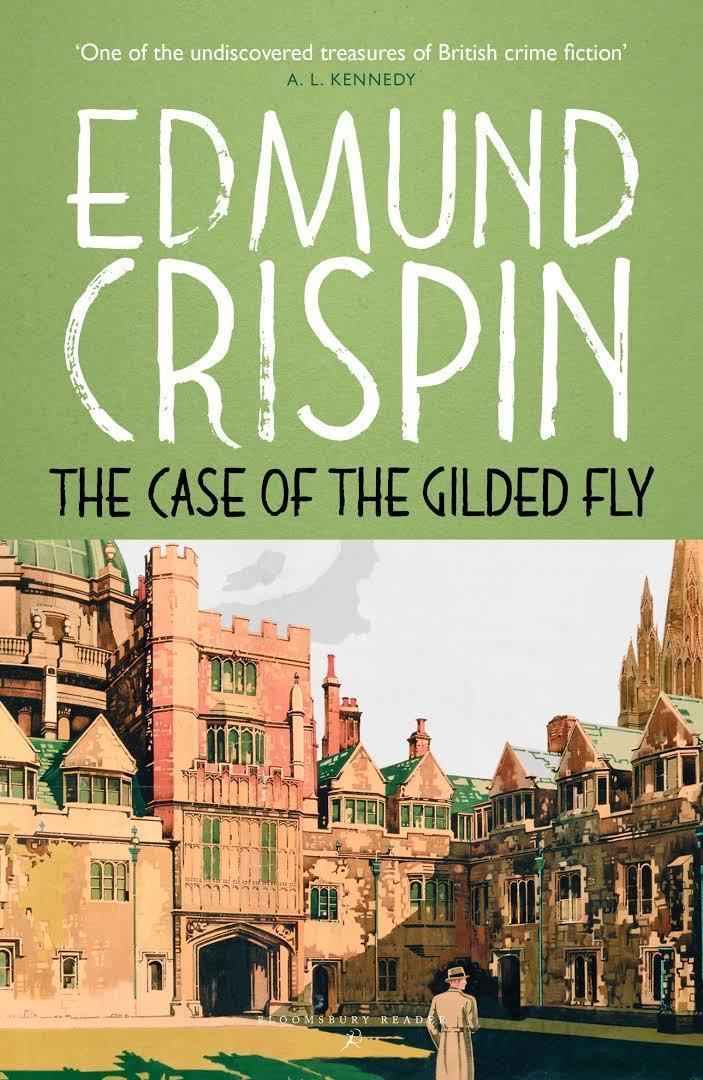7.2 /10 1 Votes
Originally published 1944 Followed by Holy Disorders | 3.6/5 Goodreads | |||||||||||||||||||||||||||||||||
 | ||||||||||||||||||||||||||||||||||
Genres Fiction, Mystery, Suspense Similar Edmund Crispin books, Gervase Fen Series books, Fiction books | ||||||||||||||||||||||||||||||||||
The Case of the Gilded Fly is a detective novel by Edmund Crispin first published in 1944. Crispin's debut novel, it contains the first appearance of eccentric amateur sleuth Gervase Fen, who is Professor of English Language and Literature in the University of Oxford. The book abounds in literary allusions ranging from classical antiquity to the mid-20th century.
Contents
In the United States, the novel was released under the title, Obsequies at Oxford. Crispin's University acquaintance Philip Larkin described how Bruce Montgomery (Crispin's real name) wrote it during his last year as an Oxford undergraduate: "During the vacation that Easter [1943] he had spent ten days writing, with his J nib and silver pen-holder, a detective story".
Plot introduction
Set in Oxford in early October 1940, immediately before the beginning of Full Term, The Case of the Gilded Fly is about the violent death of a young actress found shot in the college rooms of the organist and choirmaster, a young man who, as is generally known, is hopelessly infatuated with her. Considering the impossibility of anyone else having fired the shot, and having no other facts to go on either, the police assume that the young woman has killed herself. Gervase Fen, however, announces quite soon after the discovery of the body that he categorically rules out suicide and that he knows the identity of the murderer. To find proof with which he will be able to convince the police that a murder has been committed, he sets out on an investigation of his own without telling anybody what he knows.
The title of the novel refers to an unusual ring worn by the victim which, as it soon turns out, belongs to somebody else.
Plot summary
Up-and-coming playwright Robert Warner has chosen an Oxford repertory theatre rather than the West End as the venue for the première of his new play, Metromania. He has brought with him Rachel West, his mistress of five years, who is going to be the star of the show. Two other members of the cast are the Haskell sisters—Yseut, who is in her mid-twenties, and her younger half-sibling Helen. While Helen is a quiet beauty, Yseut's sexually promiscuous lifestyle and her condescending way of treating men have gained her many enemies among discarded lovers and jealous female rivals alike, and she has difficulty acknowledging the fact that, about a year ago, it was Robert Warner rather than she herself who ended their brief affair.
Among the motley group arriving at Oxford at the beginning of October are also Nigel Blake, a former student of Fen's who now works as a journalist in London; Nicholas Barclay, a university drop-out of independent means in search of the good life; Donald Fellowes, organist and choirmaster and desperately in love with Yseut Haskell; and Jean Whitelegge, a "plain but not unattractive" young student who fancies Fellowes and works as the secretary of the theatre club. This in crowd, and some more, are all present at a party thrown by a military officer stationed in Oxford in the course of which Yseut, completely drunk, starts threatening Warner with the host's military revolver. On the following evening she is shot with exactly that weapon while secretly searching Donald Fellowes's rooms at the college. At the alleged time of the murder, Fellowes and Nicholas Barclay are in a colleague's room on the same corridor listening to an opera on the radio, and Gervase Fen and some of his inner circle are discussing playwriting with Robert Warner in Fen's rooms one floor above. When they hear a shot they rush downstairs and discover the body.
On the one hand there is no one who mourns Yseut's death or at least pretends to do so; on the other, very few of those who expressed their dislike of her while she was still alive have an alibi. While the police, for want of clues, assume suicide, the theatre people are prone to believe that one of Yseut's numerous affairs has triggered her violent death. Although the opening of the new play is fast approaching and rehearsals become more intense, Robert Warner appears quite glad to be rid of Yseut as he has had an understudy for her waiting in the wings right from the start of rehearsals.
Fen is the only one to realise that it was not a sexual motive which prompted Yseut Haskell's killer to commit the deed. However, his reluctance to reveal what he knows, and the subsequent inability of the police to arrest the perpetrator, lead to a second murder just a few hours before the first curtain. When the show is over, and all suspects are assembled inside the theatre, the identity of the murderer is disclosed, and they meet with a violent death before they get a chance to escape.
Literary allusions
All characters, not just Fen, keep referring to works of literature in their day-to-day dealings. While some references can be regarded as common knowledge, others are quite obscure and may be to lesser-known writers. In the course of the novel, allusions are made to the following authors and their works (not an exhaustive list):
